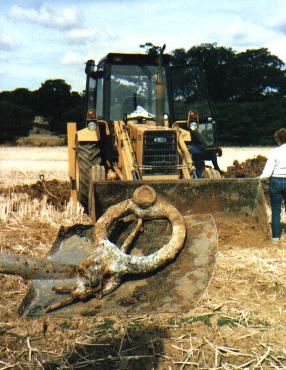ESSEX HISTORIC AIRCRAFT COLLECTION
On Wednesday 18th September 1940 13.20hrs
Gloster Hurricane V6685
249 Squadron. North Weald, Essex.
Piloted by Flt. Lt. Dennis. Geach. Parnall.
age 25 years
Crashed Margaretting Essex
after combat during 'The Battle of Britain'
A large amount of this aircraft still extant today
info@aviationmuseum.co.uk
Hurricane Crash at Ivy Barn Lane, Margaretting.
18th September 1940.
At 1.20 pm on Wednesday, 18th September 1940 a new Gloster sub contracted Hawker Hurricane, serial number V6685, with just 15 hours 5 minutes total flying time since leaving the production line dived vertically into the ground, exploded and burned in a field beside Ivy Barn Lane, Margaretting.
The aircraft crashed with terrible violence, much of the wreckage was embedded in a crater and only fragmentary remains of the pilot were found. So great was the destruction of the Hurricane that initially the Royal Air Force was unable to identify the aircraft or pilot, who was buried in the RAF section at North Weald Church on 3rd October 1940 as an unknown RAF airman.
It was only after a salvage team clearing the crash site later in October found 4 browning guns with numbers on them corresponding to the guns fitted to V6685 that the unknown pilot was identified as Flight Lieutenant Denis Geach Parnall, a 25 years old veteran with 249 Squadron North Weald who had been posted “Missing” on Wednesday, 18th September 1940.
The 18th September 1940 was a typical late summer day, a blue sky with towering white cumulus clouds. At 12.25 pm 249 Squadron was ordered off from North Weald to patrol Gravesend. Parnall was leading A Flight in his usual aircraft, serial number V6694. Soon after take off he discovered a fault with the air pressure system and gun firing mechanism of his Hurricane, unable to fire his guns he peeled off and returned to base.
Denis had a reputation as a well organised officer who was very earnest about all aspects of his job as a flight commander. No doubt with his responsibilities at the forefront of his mind he dashed from V6694 to a spare Hurricane, V6685, and took off alone at 1.10pm to try and rejoin his comrades. He did not return and was posted Missing, much to the consternation of his friends and colleagues.
Meanwhile eye witnesses at Margaretting, including schoolboy Max Meadows and farm worker Alf Bone, witnessed a brief battle at high altitude from which a Hurricane plummeted to earth in a vertical power dive. The pilot did not bale out. Climbing over the Essex countryside it is probable that Parnall’s lone Hurricane had been caught in a classic ‘bounce’ and shot down by roving enemy fighters.
An analysis of Luftwaffe claims for the relevant time on 18th September shows that most relate to combats over the Thames Estuary or south of London, but there is one by Fw Gerhard Grzymalla, a Messerschmitt 109 Pilot of 8/JG26, which may well be relevant, it is for a ‘Spitfire’ shot down near London at 1.15pm, precisely the time Parnall was lost. Confusion between Spitfires and Hurricanes by Luftwaffe pilots was common and there are no other claims or RAF losses near London at that exact time. It was Grzymallas 10th and last victory for he was himself shot down and captured 5 days later on 23rd September.
When it was discovered that the unknown airman buried at North Weald was Flight Lieutenant Parnall his family arranged with the Royal Air Force and Church of England to have his remains exhumed in August 1941and returned to his boyhood home of St Gennys on the North Cornwall coast where he was reburied in the village Churchyard.
Denis Parnall was a highly respected and much admired Officer and his loss greatly affected his friends in 249 Squadron. In a letter to the author many years after the war 249 Squadron Battle of Britain veteran Pilot Officer (later Wing Commander) Hugh Beazley wrote:
‘Denis was a very popular member of the squadron, and I personally lost a much admired friend. Had he survived the war and stayed in the service he would undoubtedly have risen to very high, even the top rank. I didn’t know him for very long, but down the years I have never forgotten him, and he was sorely missed by all the squadron.’
Robin Hill
Two excavation were carried out on V6685, the first in 1974 and the second in 1986. Most of the remains were excavated in the 1974 dig but the reason for a second was that we were convinced the control column and spade grip had been missed the first time.
The second excavation did bring to the surface the complete control and various other small parts
Parts to be recovered over the two digs are
Rolls Royce Merlin III V12 Engine
Prop hub, cowling skins, cockpit framing, undercarriage parts
wing parts, rear fuselage framing, cockpit instruments including the gun sight, rudder pedal, seat adjuster, armour plate and much more
